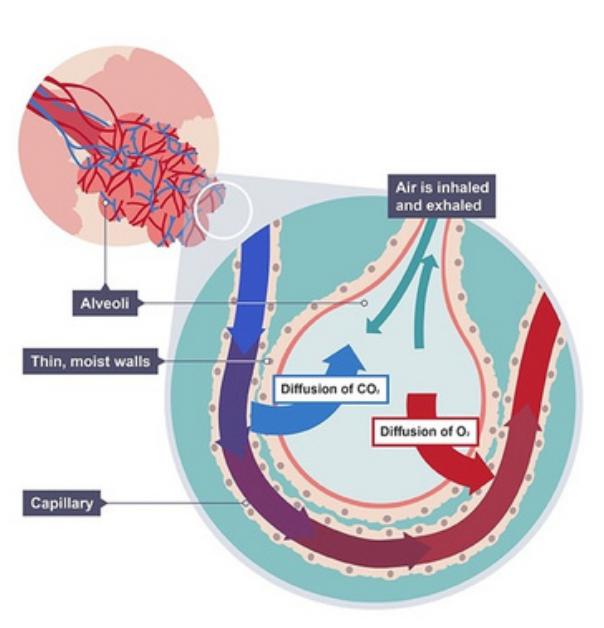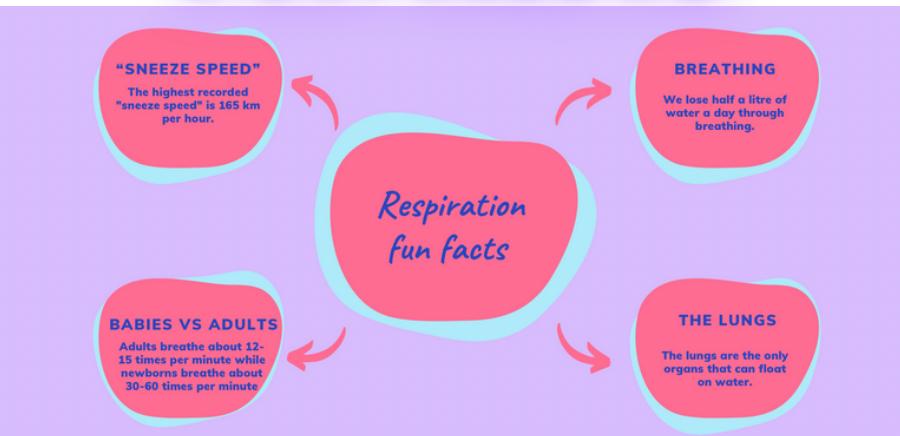
2 minute read
THE LUNGS
The lungs are the organs that are part of the RESPIRATORY SYSTEM! The respiratory system is what we use to breathe and stay alive by providing our bodies with oxygen. Everybody knows that, right? But do you know what actually happens in the respiratory system?
Respiration is all about getting oxygen into your tissues (not the ones you sneeze into) Oxygen is what keeps them going each and every single day. The things you do in your daily life, like moving, eating, thinking, playing and just generally doing stuff, are all possible because of O (oxygen, not the mobile phone network) The process of respiration releases energy in the form of ATP in all living organisms. ATP stands for Adenosine TriPhosphate. It is used as a short term energy store inside cells, ATP is broken down to release energy and this energy is used in various processes that occur within a cell
Advertisement
Breathing in, (INHALATION)
1. External intercostal muscles contract, expanding the rib cage
2 Rib cage moves up and out
3. Diaphragm contracts and flattens, pulling down
4 Volume of the thorax increases
5. Pressure inside the thorax decreases so that...
6 Air is drawn into the lungs through the nose and/or mouth
Aerobic respiration: glucose + oxygen → carbon dioxide + water (+ATP)
C H O + 6O → 6CO + 6H O
Oxygen is present
Oxidization of glucose is complete
Reactants of respiration are glucose and oxygen
Breathing out, (EXHALATION)
1. External intercostal muscles relax, dropping the rib cage downwards and inwards
2. Rib cage moves down and in
3. Diaphragm relaxes and moves upwards becoming dome shaped
4. Volume of the thorax decreases
5 Pressure inside the thorax increases so that
6. Air is forced out of he lungs and leaves through the nose and/or mouth
Products of respiration are carbon dioxide and water (and ATP)
There is a large amount of ATP made!
A molecule of air’s journey...
The molecule of air would first travel past the larynx, down the trachea, past the rings of cartilage and into a lung
Then, it travels into a bronchus, then a bronchiole and finally into the alveoli, which allow gas exchange to occur and for the molecule of air to diffuse into your blood vessels and then into your cells
Adaptations of the ALVEOLI:

Thin walls: alveolar walls are one cell thick providing gases with a short diffusion distance
Large surface area: many alveoli are present in the lungs with a shape that further increases surface area

Moist walls: gases dissolve in the moisture helping them to pass across the gas exchange surface/ speeds up the diffusion
Permeable walls - allow gases to pass through
WHY DO LARGE, COMPLEX MULTICELLULAR ORAGANISMS REQUIRE SPECIALISED BREATHING SYSTEMS?
As the size of an organism increases, it’s surface area to volume ratio decreases. This means it has relatively low surface area available for substances to diffuse through, so the rate of diffusion may not be fast enough to meet its cells requirements. Large multicellular organisms therefore cannot rely on diffusion alone to supply their oxygen and therefore require specialised breathing systems
WHAT ARE THE DIFERENCES IN COMPOSITION OF THE AIR, IN THE AIR WE INHALE AND THE AIR WE EXHALE?
When we exhale, the composition of the air is almost completely the same as the air we inhale Only the percentage of carbon dioxide and the percentage of oxygen changes.
Inhalation
Oxygen: 21%
Carbon dioxide: 0 03%
Exhalation
Oxygen: 16%
Carbon dioxide: 4%



